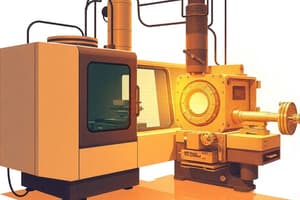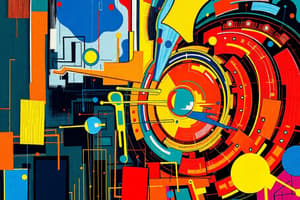Podcast
Questions and Answers
What does CNC stand for?
What does CNC stand for?
- Computerized Network Control
- Centralized Numeric Command
- Controlled Numerical Computation
- Computer Numerical Control (correct)
Which of the following is a primary component of a CNC system?
Which of the following is a primary component of a CNC system?
- Feedback System (correct)
- Computer Network
- Power Supply Unit
- Human Interface Module
What is the purpose of CAM software in the CNC process?
What is the purpose of CAM software in the CNC process?
- To provide user interface for CNC machines
- To monitor machine operations
- To create the initial design
- To convert designs into machine-readable code (correct)
What advantage does CNC offer in manufacturing?
What advantage does CNC offer in manufacturing?
Which type of CNC machine is specifically designed to rotate workpieces?
Which type of CNC machine is specifically designed to rotate workpieces?
Which programming language is standard for CNC operations?
Which programming language is standard for CNC operations?
What is a common maintenance task for CNC machines?
What is a common maintenance task for CNC machines?
In which field is CNC technology widely applied?
In which field is CNC technology widely applied?
Flashcards are hidden until you start studying
Study Notes
CNC Overview
- Definition: CNC stands for Computer Numerical Control, a technology used to automate machine tools through computer programming.
- Purpose: Enhances precision, efficiency, and repeatability in manufacturing processes.
Components of CNC Systems
- Computer/Controller: The brain of the CNC system that processes commands.
- Software: Programs like CAD (Computer-Aided Design) and CAM (Computer-Aided Manufacturing) used for design and tool paths.
- Machine Tool: The hardware (e.g., mills, lathes) that performs the cutting or shaping of materials.
- Feedback System: Sensors and encoders that provide real-time data to maintain accuracy.
CNC Process
- Design: Create a design using CAD software.
- Convert Design: Use CAM software to convert the design into a machine-readable code (G-code).
- Set Up Machine: Load the G-code onto the CNC machine, set workpieces, and tools.
- Machining: The CNC machine executes the code to perform operations like cutting, drilling, or engraving.
- Finishing: Post-processing steps to refine the part (e.g., deburring, polishing).
Advantages of CNC
- Precision: High accuracy in manufacturing parts.
- Consistency: Uniform production, reducing variances in output.
- Automation: Reduces labor costs and human error.
- Complex Shapes: Ability to create intricate designs not feasible with manual tools.
- Flexibility: Easy to change designs and settings for different projects.
Common CNC Machines
- CNC Mills: Used for cutting and shaping materials in multiple axes.
- CNC Lathes: Rotate workpieces to cut and shape them.
- CNC Plasma Cutters: Use plasma to cut through materials.
- CNC Laser Cutters: Utilize lasers for precise cutting and engraving.
CNC Programming
- G-code: The standard programming language for CNC, providing instructions for movement and operations.
- M-code: Used for miscellaneous functions (e.g., tool changes, spindle control).
Applications of CNC
- Manufacturing: Precision parts for automotive, aerospace, and electronics industries.
- Prototyping: Rapid production of prototypes for product testing and development.
- Art and Design: Creation of intricate designs in various materials.
Maintenance of CNC Machines
- Regular Inspection: Check mechanical components for wear and tear.
- Lubrication: Ensure moving parts are lubricated to prevent friction.
- Calibration: Regularly calibrate machines to maintain accuracy.
- Cleaning: Keep work areas and machines clean to prevent contamination.
Trends in CNC Technology
- IoT Integration: Connecting CNC machines to the Internet for remote monitoring and analytics.
- Automation & Robotics: Enhanced automation in CNC operations through robotic integration.
- Advanced Materials: Use of CNC in processing new materials, including composites and advanced alloys.
CNC Overview
- CNC stands for Computer Numerical Control, enabling automation of machine tools via computer programming.
- The technology boosts precision, efficiency, and repeatability in manufacturing processes.
Components of CNC Systems
- Computer/Controller: Acts as the central processing unit, executing commands to control machinery.
- Software: CAD (Computer-Aided Design) is employed for designing, while CAM (Computer-Aided Manufacturing) converts designs into operational tool paths.
- Machine Tool: Refers to equipment such as mills and lathes, responsible for cutting or shaping materials.
- Feedback System: Sensors and encoders provide real-time data, ensuring precision and accuracy during operations.
CNC Process
- Design: Utilize CAD software to create detailed designs.
- Convert Design: CAM software produces machine-readable G-code from the design.
- Set Up Machine: G-code is loaded onto the CNC machine, alongside workpieces and tools preparation.
- Machining: The CNC machine interprets and executes the code, performing tasks like cutting, drilling, or engraving.
- Finishing: Involves post-processing actions, such as deburring and polishing to perfect the finished part.
Advantages of CNC
- High Precision: Guarantees exceptional accuracy in manufactured components.
- Consistency: Promotes uniform production, minimizing output variations.
- Automation: Decreases labor costs and mitigates human errors.
- Capability for Complex Shapes: Facilitates the creation of intricate designs beyond manual tool capabilities.
- Flexibility: Adapts easily to changing designs and project requirements.
Common CNC Machines
- CNC Mills: Versatile machines that cut and shape materials across multiple axes.
- CNC Lathes: Rotate workpieces, primarily used for shaping cylindrical designs.
- CNC Plasma Cutters: Employ plasma technology for cutting through various materials.
- CNC Laser Cutters: Implement lasers to achieve precise cutting and engraving tasks.
CNC Programming
- G-code: The primary programming language for CNC, detailing movement and operational instructions for machines.
- M-code: Utilized for miscellaneous functions, including tool changes and spindle management.
Applications of CNC
- Manufacturing: Produces precision components for sectors such as automotive, aerospace, and electronics.
- Prototyping: Enables rapid creation of prototypes critical for product testing and development phases.
- Art and Design: Facilitates the crafting of intricate designs across various materials, merging technology and creativity.
Maintenance of CNC Machines
- Regular Inspection: Involves assessing mechanical components for wear and potential failures.
- Lubrication: Essential for promoting smooth movement and reducing friction in moving parts.
- Calibration: Consistent machine calibration is vital for sustaining accuracy in production.
- Cleaning: Keeping machinery and work environments clean minimizes contamination risks.
Trends in CNC Technology
- IoT Integration: Enhances capability by linking CNC machines to the Internet for remote monitoring and data analytics.
- Automation & Robotics: Advances in automation and robotics optimization in CNC operations, increasing productivity.
- Advanced Materials: Expands application of CNC technology in processing innovative materials, including composites and specialized alloys.
Studying That Suits You
Use AI to generate personalized quizzes and flashcards to suit your learning preferences.



